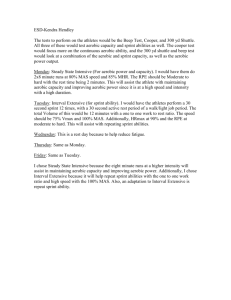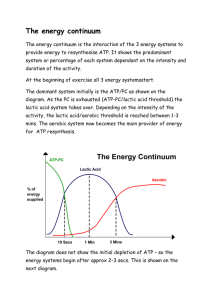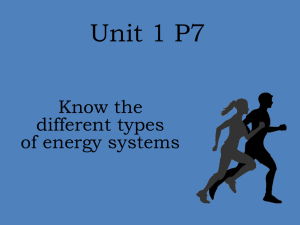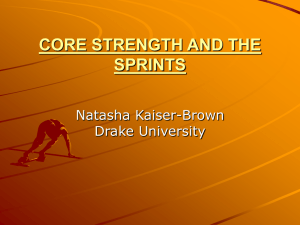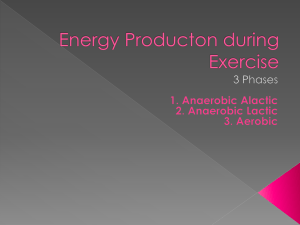SAC 2 & 3 PREPARATION
advertisement
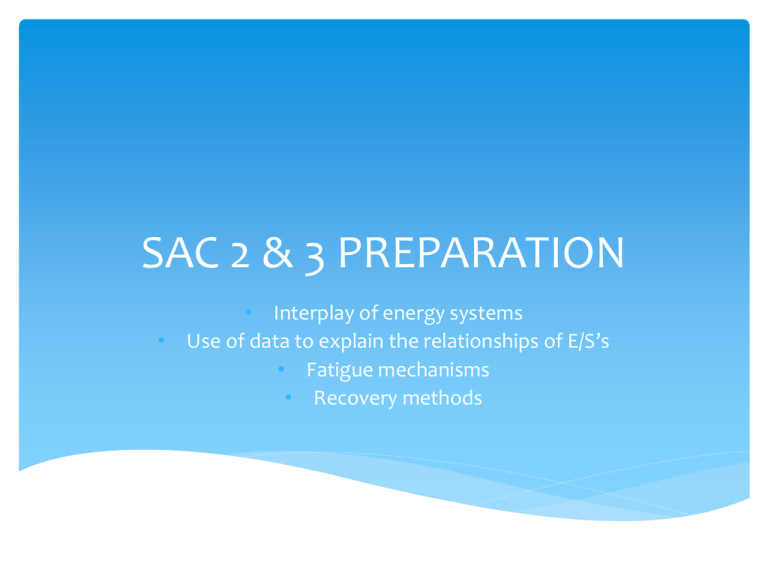
SAC 2 & 3 PREPARATION • Interplay of energy systems • Use of data to explain the relationships of E/S’s • Fatigue mechanisms • Recovery methods SAC 3 ACUTE RESPONSES TO PHYSICAL ACTIVITY Make sure you know the 3 systems that acute responses occur in: Circulatory Respiratory Muscular Changes take place immediately exercise begins and these changes return to normal after exercise ends. What activities did we do? 50m sprint (maximal intensity) 1 minute max sit up test 400m sprint (maximal intensity) 800m run (maximal intensity) Basketball competitive game (15 minutes) What happened to each of the acute reponses for each of the 3 systems for the activities? Graphs – to do today! Draw and label appropriate graphs to show the data your group collected relating to heart rate, respiratory frequency and body temperature for each activity undertaken. Draw 3 graphs – one for HR, one for RR and for Body Temp. Acute changes What are acute changes compared with Chronic adaptations? Use your data: what has exercise intensity and duration got to do with acute responses? Talk about this as a class. How would the results be different if we were dealing with an elite aerobic athlete? SAC 4 – 4 x 40 second sprints Active recovery ACTIVE RECOVERY - maintains O2 levels higher than if the person was simply to sit down. This speeds up removal of lactic acid that actually impedes recovery It creates a ‘muscle pump’ that increases rate of oxygen supply and waste removal via circulatory system (muscles pressing on blood vessels surrounding active / working muscles) Prevents venous pooling Passive recovery PASSIVE RECOVERY - PC is restored as soon as rest occurs (alactacid (rapid) part of oxygen debt. 10 minutes to restore 100% of PC. Please note that low pH caused by lactic acid accumulation will slow PC restoration, as will a slow supply of oxygen. This is why having a high aerobic capacity can actually benefit anaerobic performances as well and why teams focus on building this up during pre-season training. Hydrogen ions When lactate threshold is exceeded we see large amounts of hydrogen ions accumulate – this is usually about 85% MHR. ACTIVE recovery is recommended to remove H+ ion build up because of the reasons mentioned (previous slide). If you rested (passive) it will take 1-2 hours to remove H+ ions. If you do an active recovery this drops to 30 min – 1 hour. Think about the sprints… Active versus Passive… How would the type of recovery (2min rest vs 2 min Active recovery) effect the percentage contribution of the three energy systems? Would a passive recovery assist PC stores – so in the second sprint how would this effect the % use of the ATP PC system? Eg 1st sprint ATP PC % = 30% for both subjects, in the second sprint who would use the ATPPC system more – the active or passive recovery? Why… Eg 2nd sprint ATP PC % = 27% passive recovery and only 20% for the active recovery – explain….. Data – use it!!! In this SAC you will need to use the data to prove what you know about energy system interplay & recovery. You know: Distance covered Heart rate Respiratory rate PC System Which sprint would have had the higher PC contribution? The first sprint – because from the word ‘go’ all three E/S’s start to release energy from the breakdown of ATP to ADP for muscle contractions. The ATP PC system would contribute most of the energy for the first 5-6 seconds at which point the lactic acid system would take over as the main producer and keep this role until the end of the 40 second sprint. Remember that all along the aerobic energy system is increasing its contribution – how much do you think it would contribute at the 40 second mark??? 30-35% Lactic Acid System After the 6 second mark the Lactic Acid system starts to dominate energy production. With an active recovery we have less use of the PC system and hence slower times or drop in distance covered – this is evidence of the lactic acid system being used. If the respiratory rate increases how does this indicate the use of the lactic acid system? After the sprint if RR increases this may indciate the need to break down lactate and H+ ions. RR increases when LIP or LSS is exceeded. Passive recovery would have higher lactate and H+ ion levels – active recovery would double the amount of H+ and lactate broken down. Aerobic Energy System The aerobic energy system will contribute the most to the final sprint especially with the active recovery, the RR are higher but the ATP rate is slower and muscle contractions associated with lower distances recorded and slower work rates. The aerobic energy system in recovery: Oxidises lactate and hydrogen ions Resynthesises / restores PC By the 4th sprint the aerobic ES will contribute above 50% despite it only lasting 40 seconds as there has been continuous activation of the aerobic ES. Dietary recovery strategies High GI diet post exercise Carb gels Water / hydration Non Dietary recovery strategies Active recoveries Application of ice vests Use of cool rooms during ½ time break etc Massage

